Analysis of Performance and Reward Management in the Workplace Report
VerifiedAdded on 2022/10/12
|7
|2204
|19
Report
AI Summary
This report delves into the critical aspects of performance and reward management within an organizational context. It begins by outlining the two primary purposes of performance management, such as providing feedback and identifying development needs, and their direct relationship to business objectives. The report then explores the connection between motivation and performance management, referencing Herzberg's two-factor theory and Maslow's hierarchy of needs to explain how different factors influence employee behavior. It further examines the dual purposes of rewards within performance management, differentiating between financial and non-financial components of an effective reward system. The report also identifies factors a manager should consider when addressing both positive and negative employee performance, including sources of information needed for performance and reward management processes. The report concludes by emphasizing the significance of effective performance management in fostering employee productivity and growth, supported by relevant references.

qwertyuiopasdfghjklzxcvbnmqw
ertyuiopasdfghjklzxcvbnmqwert
yuiopasdfghjklzxcvbnmqwertyui
opasdfghjklzxcvbnmqwertyuiop
asdfghjklzxcvbnmqwertyuiopasd
fghjklzxcvbnmqwertyuiopasdfgh
jklzxcvbnmqwertyuiopasdfghjkl
zxcvbnmqwertyuiopasdfghjklzxc
vbnmqwertyuiopasdfghjklzxcvb
nmqwertyuiopasdfghjklzxcvbnm
qwertyuiopasdfghjklzxcvbnmqw
ertyuiopasdfghjklzxcvbnmqwert
yuiopasdfghjklzxcvbnmqwertyui
opasdfghjklzxcvbnmqwertyuiop
asdfghjklzxcvbnmqwertyuiopasd
fghjklzxcvbnmqwertyuiopasdfgh
jklzxcvbnmrtyuiopasdfghjklzxcv
HRM
ertyuiopasdfghjklzxcvbnmqwert
yuiopasdfghjklzxcvbnmqwertyui
opasdfghjklzxcvbnmqwertyuiop
asdfghjklzxcvbnmqwertyuiopasd
fghjklzxcvbnmqwertyuiopasdfgh
jklzxcvbnmqwertyuiopasdfghjkl
zxcvbnmqwertyuiopasdfghjklzxc
vbnmqwertyuiopasdfghjklzxcvb
nmqwertyuiopasdfghjklzxcvbnm
qwertyuiopasdfghjklzxcvbnmqw
ertyuiopasdfghjklzxcvbnmqwert
yuiopasdfghjklzxcvbnmqwertyui
opasdfghjklzxcvbnmqwertyuiop
asdfghjklzxcvbnmqwertyuiopasd
fghjklzxcvbnmqwertyuiopasdfgh
jklzxcvbnmrtyuiopasdfghjklzxcv
HRM
Paraphrase This Document
Need a fresh take? Get an instant paraphrase of this document with our AI Paraphraser
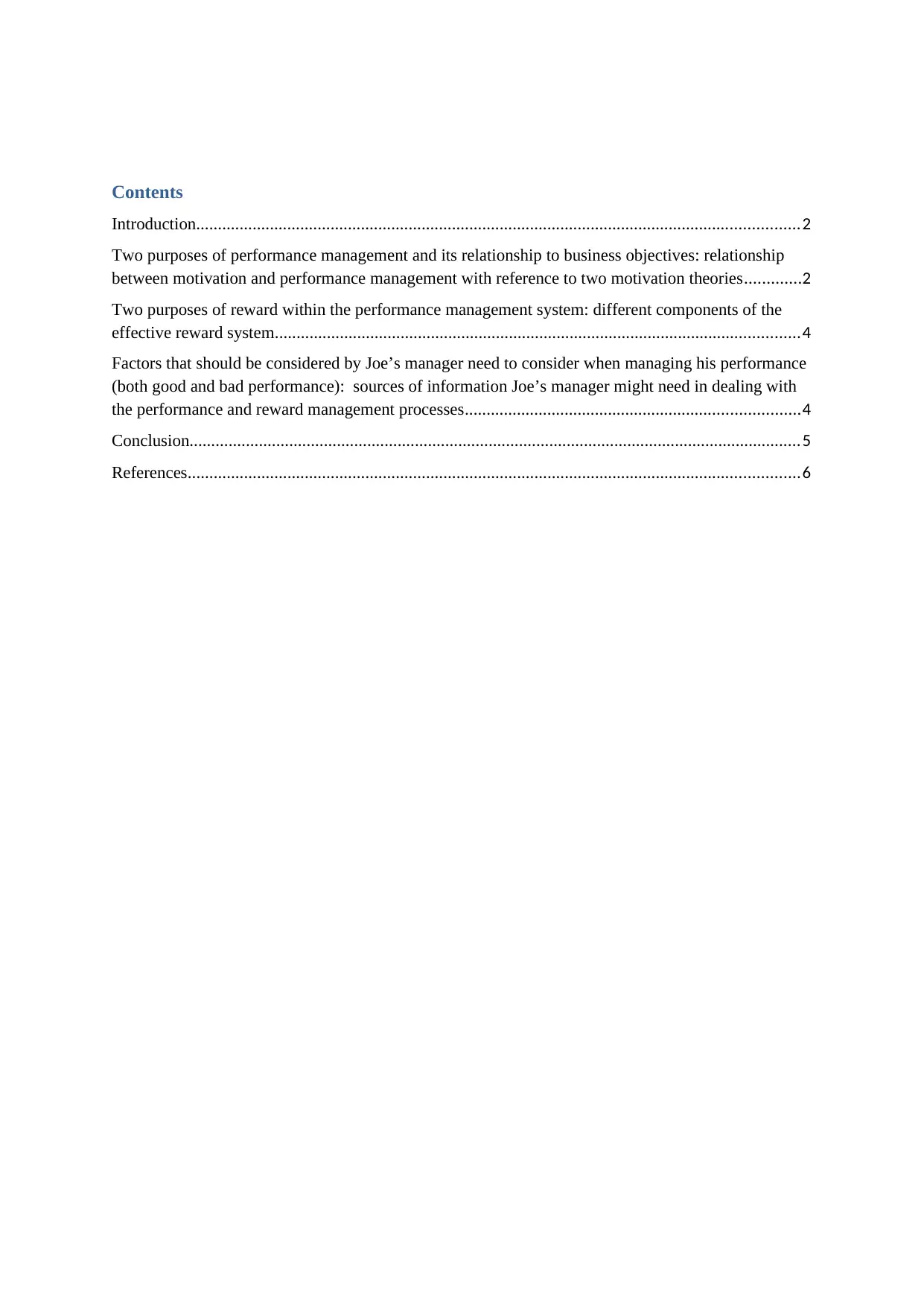
Contents
Introduction...........................................................................................................................................2
Two purposes of performance management and its relationship to business objectives: relationship
between motivation and performance management with reference to two motivation theories.............2
Two purposes of reward within the performance management system: different components of the
effective reward system.........................................................................................................................4
Factors that should be considered by Joe’s manager need to consider when managing his performance
(both good and bad performance): sources of information Joe’s manager might need in dealing with
the performance and reward management processes.............................................................................4
Conclusion.............................................................................................................................................5
References.............................................................................................................................................6
Introduction...........................................................................................................................................2
Two purposes of performance management and its relationship to business objectives: relationship
between motivation and performance management with reference to two motivation theories.............2
Two purposes of reward within the performance management system: different components of the
effective reward system.........................................................................................................................4
Factors that should be considered by Joe’s manager need to consider when managing his performance
(both good and bad performance): sources of information Joe’s manager might need in dealing with
the performance and reward management processes.............................................................................4
Conclusion.............................................................................................................................................5
References.............................................................................................................................................6
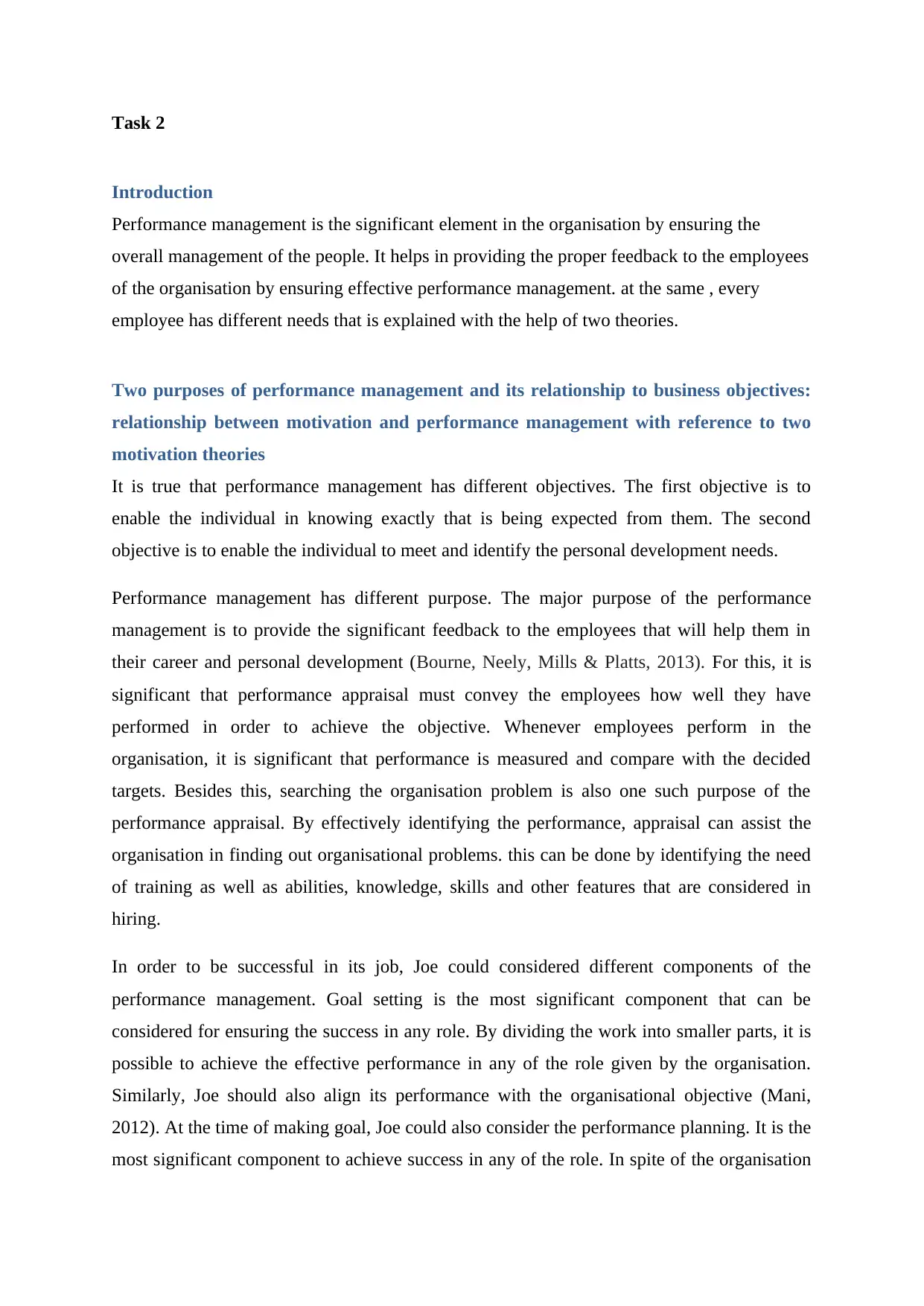
Task 2
Introduction
Performance management is the significant element in the organisation by ensuring the
overall management of the people. It helps in providing the proper feedback to the employees
of the organisation by ensuring effective performance management. at the same , every
employee has different needs that is explained with the help of two theories.
Two purposes of performance management and its relationship to business objectives:
relationship between motivation and performance management with reference to two
motivation theories
It is true that performance management has different objectives. The first objective is to
enable the individual in knowing exactly that is being expected from them. The second
objective is to enable the individual to meet and identify the personal development needs.
Performance management has different purpose. The major purpose of the performance
management is to provide the significant feedback to the employees that will help them in
their career and personal development (Bourne, Neely, Mills & Platts, 2013). For this, it is
significant that performance appraisal must convey the employees how well they have
performed in order to achieve the objective. Whenever employees perform in the
organisation, it is significant that performance is measured and compare with the decided
targets. Besides this, searching the organisation problem is also one such purpose of the
performance appraisal. By effectively identifying the performance, appraisal can assist the
organisation in finding out organisational problems. this can be done by identifying the need
of training as well as abilities, knowledge, skills and other features that are considered in
hiring.
In order to be successful in its job, Joe could considered different components of the
performance management. Goal setting is the most significant component that can be
considered for ensuring the success in any role. By dividing the work into smaller parts, it is
possible to achieve the effective performance in any of the role given by the organisation.
Similarly, Joe should also align its performance with the organisational objective (Mani,
2012). At the time of making goal, Joe could also consider the performance planning. It is the
most significant component to achieve success in any of the role. In spite of the organisation
Introduction
Performance management is the significant element in the organisation by ensuring the
overall management of the people. It helps in providing the proper feedback to the employees
of the organisation by ensuring effective performance management. at the same , every
employee has different needs that is explained with the help of two theories.
Two purposes of performance management and its relationship to business objectives:
relationship between motivation and performance management with reference to two
motivation theories
It is true that performance management has different objectives. The first objective is to
enable the individual in knowing exactly that is being expected from them. The second
objective is to enable the individual to meet and identify the personal development needs.
Performance management has different purpose. The major purpose of the performance
management is to provide the significant feedback to the employees that will help them in
their career and personal development (Bourne, Neely, Mills & Platts, 2013). For this, it is
significant that performance appraisal must convey the employees how well they have
performed in order to achieve the objective. Whenever employees perform in the
organisation, it is significant that performance is measured and compare with the decided
targets. Besides this, searching the organisation problem is also one such purpose of the
performance appraisal. By effectively identifying the performance, appraisal can assist the
organisation in finding out organisational problems. this can be done by identifying the need
of training as well as abilities, knowledge, skills and other features that are considered in
hiring.
In order to be successful in its job, Joe could considered different components of the
performance management. Goal setting is the most significant component that can be
considered for ensuring the success in any role. By dividing the work into smaller parts, it is
possible to achieve the effective performance in any of the role given by the organisation.
Similarly, Joe should also align its performance with the organisational objective (Mani,
2012). At the time of making goal, Joe could also consider the performance planning. It is the
most significant component to achieve success in any of the role. In spite of the organisation
⊘ This is a preview!⊘
Do you want full access?
Subscribe today to unlock all pages.

Trusted by 1+ million students worldwide
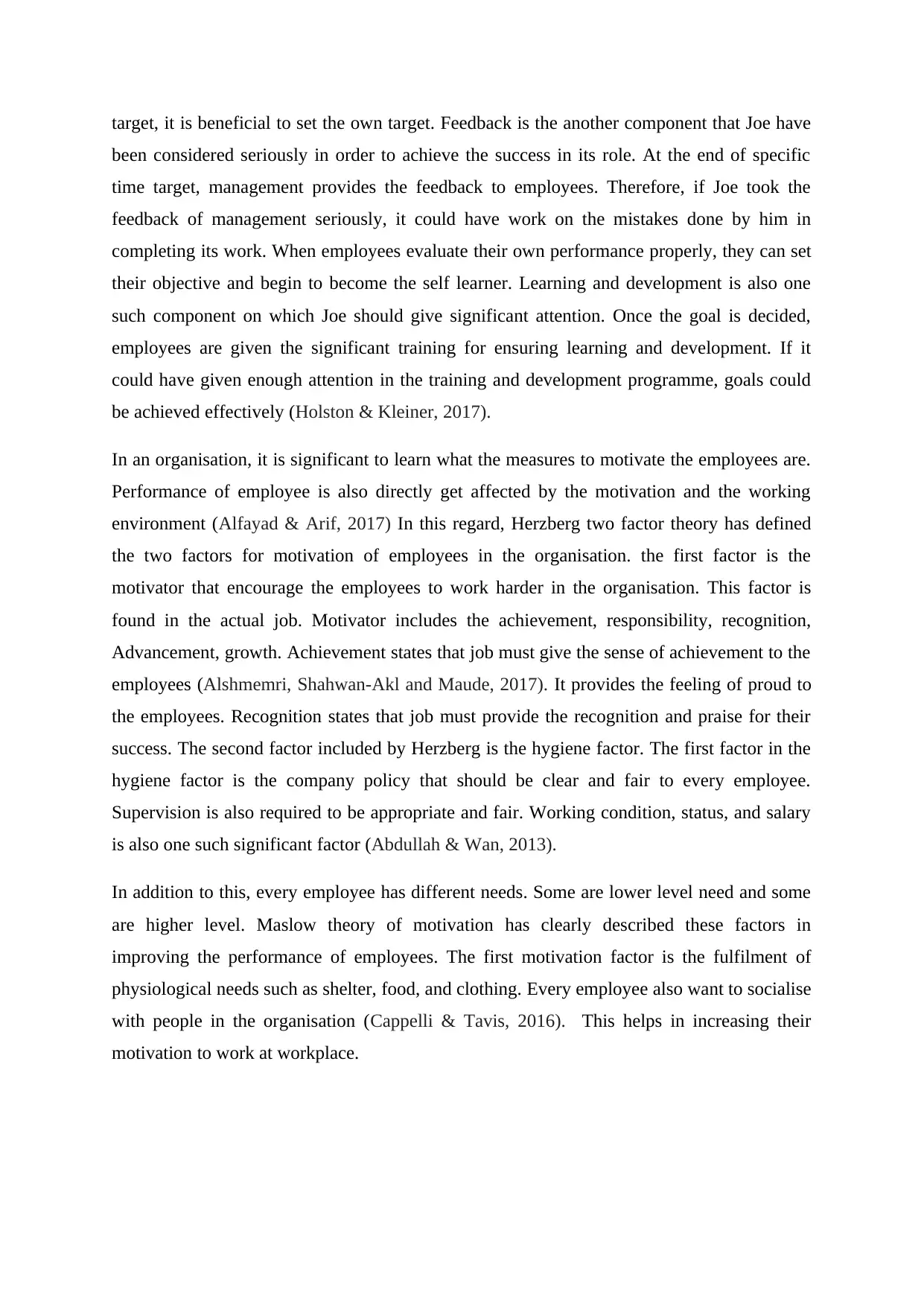
target, it is beneficial to set the own target. Feedback is the another component that Joe have
been considered seriously in order to achieve the success in its role. At the end of specific
time target, management provides the feedback to employees. Therefore, if Joe took the
feedback of management seriously, it could have work on the mistakes done by him in
completing its work. When employees evaluate their own performance properly, they can set
their objective and begin to become the self learner. Learning and development is also one
such component on which Joe should give significant attention. Once the goal is decided,
employees are given the significant training for ensuring learning and development. If it
could have given enough attention in the training and development programme, goals could
be achieved effectively (Holston & Kleiner, 2017).
In an organisation, it is significant to learn what the measures to motivate the employees are.
Performance of employee is also directly get affected by the motivation and the working
environment (Alfayad & Arif, 2017) In this regard, Herzberg two factor theory has defined
the two factors for motivation of employees in the organisation. the first factor is the
motivator that encourage the employees to work harder in the organisation. This factor is
found in the actual job. Motivator includes the achievement, responsibility, recognition,
Advancement, growth. Achievement states that job must give the sense of achievement to the
employees (Alshmemri, Shahwan-Akl and Maude, 2017). It provides the feeling of proud to
the employees. Recognition states that job must provide the recognition and praise for their
success. The second factor included by Herzberg is the hygiene factor. The first factor in the
hygiene factor is the company policy that should be clear and fair to every employee.
Supervision is also required to be appropriate and fair. Working condition, status, and salary
is also one such significant factor (Abdullah & Wan, 2013).
In addition to this, every employee has different needs. Some are lower level need and some
are higher level. Maslow theory of motivation has clearly described these factors in
improving the performance of employees. The first motivation factor is the fulfilment of
physiological needs such as shelter, food, and clothing. Every employee also want to socialise
with people in the organisation (Cappelli & Tavis, 2016). This helps in increasing their
motivation to work at workplace.
been considered seriously in order to achieve the success in its role. At the end of specific
time target, management provides the feedback to employees. Therefore, if Joe took the
feedback of management seriously, it could have work on the mistakes done by him in
completing its work. When employees evaluate their own performance properly, they can set
their objective and begin to become the self learner. Learning and development is also one
such component on which Joe should give significant attention. Once the goal is decided,
employees are given the significant training for ensuring learning and development. If it
could have given enough attention in the training and development programme, goals could
be achieved effectively (Holston & Kleiner, 2017).
In an organisation, it is significant to learn what the measures to motivate the employees are.
Performance of employee is also directly get affected by the motivation and the working
environment (Alfayad & Arif, 2017) In this regard, Herzberg two factor theory has defined
the two factors for motivation of employees in the organisation. the first factor is the
motivator that encourage the employees to work harder in the organisation. This factor is
found in the actual job. Motivator includes the achievement, responsibility, recognition,
Advancement, growth. Achievement states that job must give the sense of achievement to the
employees (Alshmemri, Shahwan-Akl and Maude, 2017). It provides the feeling of proud to
the employees. Recognition states that job must provide the recognition and praise for their
success. The second factor included by Herzberg is the hygiene factor. The first factor in the
hygiene factor is the company policy that should be clear and fair to every employee.
Supervision is also required to be appropriate and fair. Working condition, status, and salary
is also one such significant factor (Abdullah & Wan, 2013).
In addition to this, every employee has different needs. Some are lower level need and some
are higher level. Maslow theory of motivation has clearly described these factors in
improving the performance of employees. The first motivation factor is the fulfilment of
physiological needs such as shelter, food, and clothing. Every employee also want to socialise
with people in the organisation (Cappelli & Tavis, 2016). This helps in increasing their
motivation to work at workplace.
Paraphrase This Document
Need a fresh take? Get an instant paraphrase of this document with our AI Paraphraser
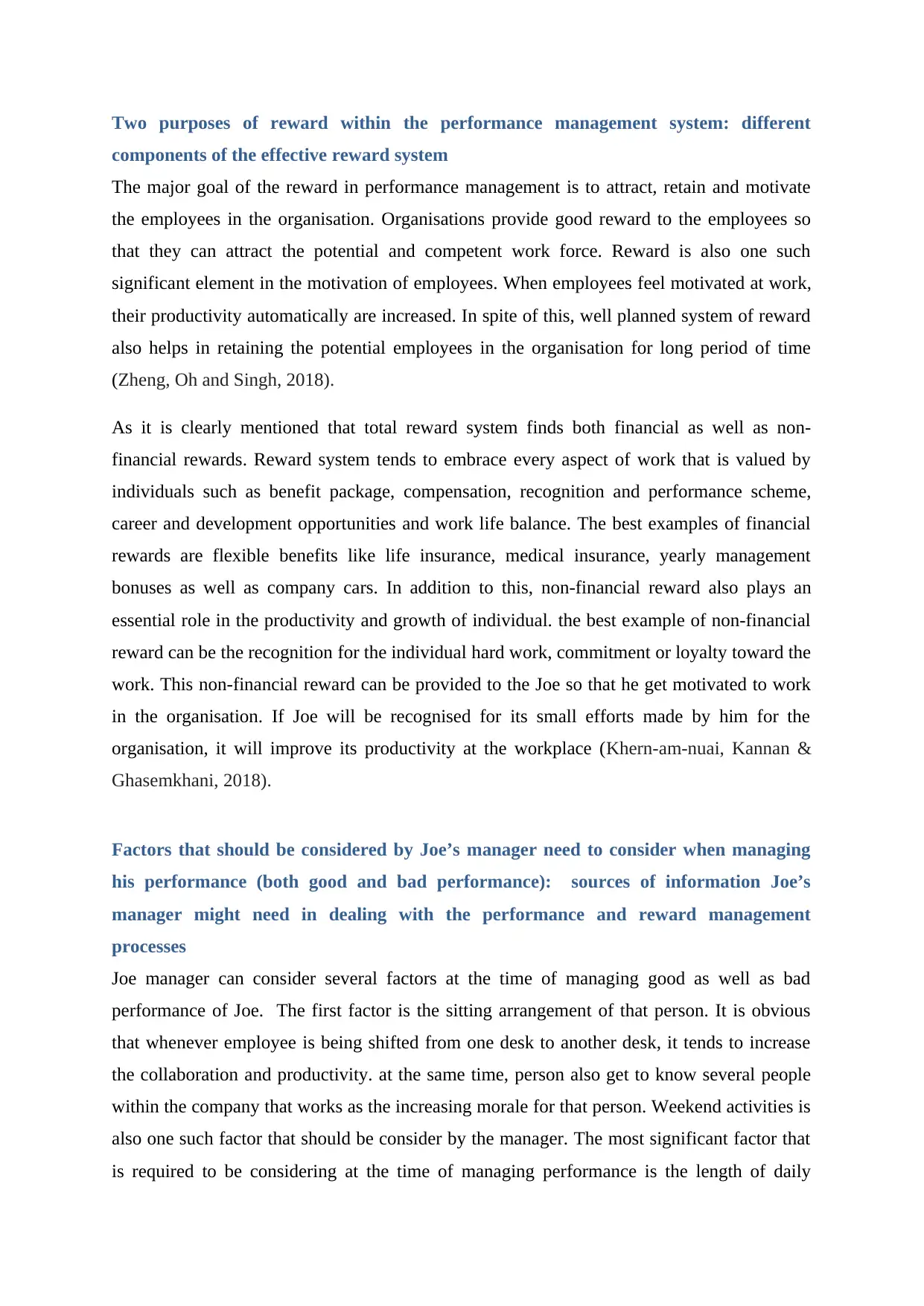
Two purposes of reward within the performance management system: different
components of the effective reward system
The major goal of the reward in performance management is to attract, retain and motivate
the employees in the organisation. Organisations provide good reward to the employees so
that they can attract the potential and competent work force. Reward is also one such
significant element in the motivation of employees. When employees feel motivated at work,
their productivity automatically are increased. In spite of this, well planned system of reward
also helps in retaining the potential employees in the organisation for long period of time
(Zheng, Oh and Singh, 2018).
As it is clearly mentioned that total reward system finds both financial as well as non-
financial rewards. Reward system tends to embrace every aspect of work that is valued by
individuals such as benefit package, compensation, recognition and performance scheme,
career and development opportunities and work life balance. The best examples of financial
rewards are flexible benefits like life insurance, medical insurance, yearly management
bonuses as well as company cars. In addition to this, non-financial reward also plays an
essential role in the productivity and growth of individual. the best example of non-financial
reward can be the recognition for the individual hard work, commitment or loyalty toward the
work. This non-financial reward can be provided to the Joe so that he get motivated to work
in the organisation. If Joe will be recognised for its small efforts made by him for the
organisation, it will improve its productivity at the workplace (Khern-am-nuai, Kannan &
Ghasemkhani, 2018).
Factors that should be considered by Joe’s manager need to consider when managing
his performance (both good and bad performance): sources of information Joe’s
manager might need in dealing with the performance and reward management
processes
Joe manager can consider several factors at the time of managing good as well as bad
performance of Joe. The first factor is the sitting arrangement of that person. It is obvious
that whenever employee is being shifted from one desk to another desk, it tends to increase
the collaboration and productivity. at the same time, person also get to know several people
within the company that works as the increasing morale for that person. Weekend activities is
also one such factor that should be consider by the manager. The most significant factor that
is required to be considering at the time of managing performance is the length of daily
components of the effective reward system
The major goal of the reward in performance management is to attract, retain and motivate
the employees in the organisation. Organisations provide good reward to the employees so
that they can attract the potential and competent work force. Reward is also one such
significant element in the motivation of employees. When employees feel motivated at work,
their productivity automatically are increased. In spite of this, well planned system of reward
also helps in retaining the potential employees in the organisation for long period of time
(Zheng, Oh and Singh, 2018).
As it is clearly mentioned that total reward system finds both financial as well as non-
financial rewards. Reward system tends to embrace every aspect of work that is valued by
individuals such as benefit package, compensation, recognition and performance scheme,
career and development opportunities and work life balance. The best examples of financial
rewards are flexible benefits like life insurance, medical insurance, yearly management
bonuses as well as company cars. In addition to this, non-financial reward also plays an
essential role in the productivity and growth of individual. the best example of non-financial
reward can be the recognition for the individual hard work, commitment or loyalty toward the
work. This non-financial reward can be provided to the Joe so that he get motivated to work
in the organisation. If Joe will be recognised for its small efforts made by him for the
organisation, it will improve its productivity at the workplace (Khern-am-nuai, Kannan &
Ghasemkhani, 2018).
Factors that should be considered by Joe’s manager need to consider when managing
his performance (both good and bad performance): sources of information Joe’s
manager might need in dealing with the performance and reward management
processes
Joe manager can consider several factors at the time of managing good as well as bad
performance of Joe. The first factor is the sitting arrangement of that person. It is obvious
that whenever employee is being shifted from one desk to another desk, it tends to increase
the collaboration and productivity. at the same time, person also get to know several people
within the company that works as the increasing morale for that person. Weekend activities is
also one such factor that should be consider by the manager. The most significant factor that
is required to be considering at the time of managing performance is the length of daily
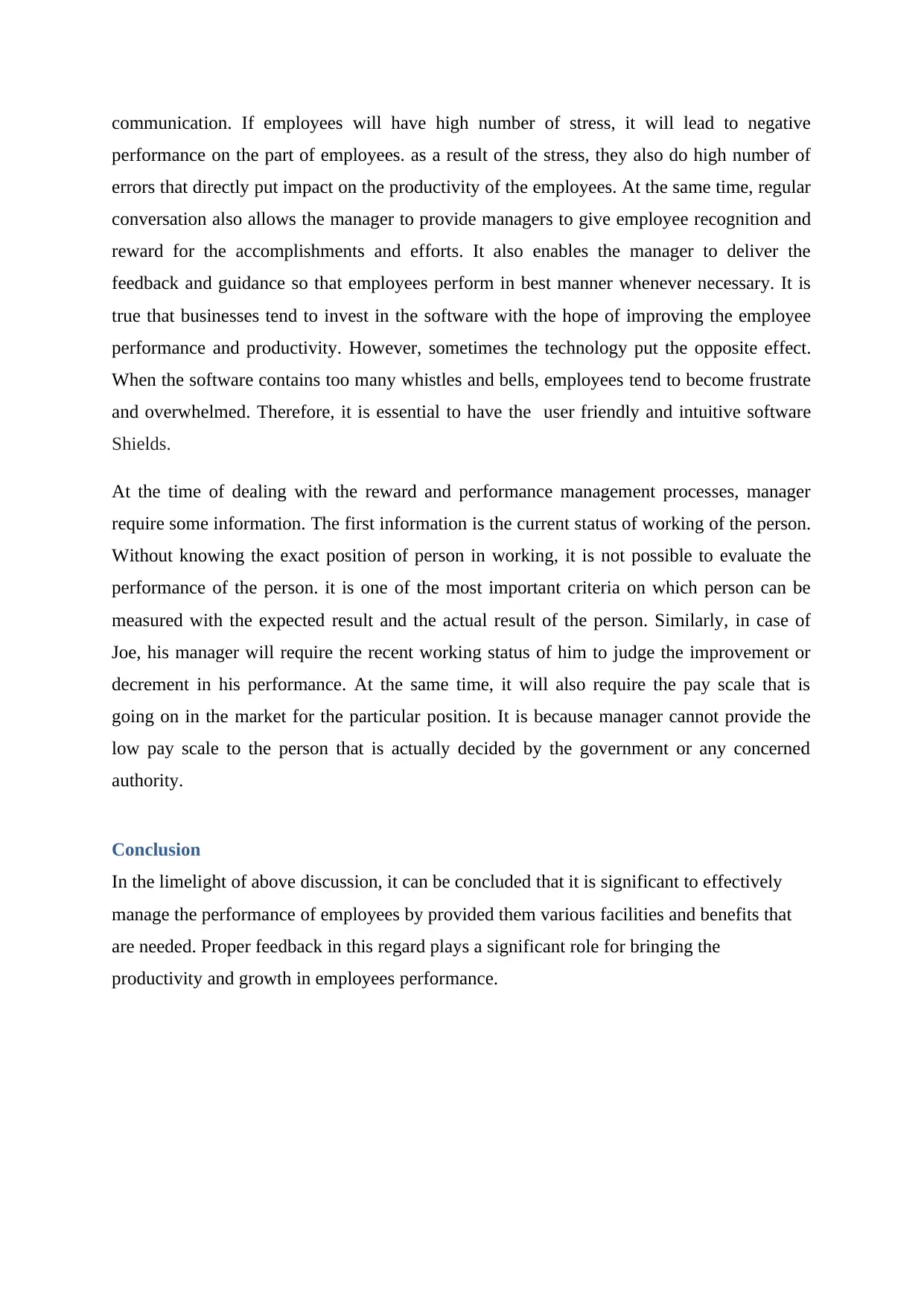
communication. If employees will have high number of stress, it will lead to negative
performance on the part of employees. as a result of the stress, they also do high number of
errors that directly put impact on the productivity of the employees. At the same time, regular
conversation also allows the manager to provide managers to give employee recognition and
reward for the accomplishments and efforts. It also enables the manager to deliver the
feedback and guidance so that employees perform in best manner whenever necessary. It is
true that businesses tend to invest in the software with the hope of improving the employee
performance and productivity. However, sometimes the technology put the opposite effect.
When the software contains too many whistles and bells, employees tend to become frustrate
and overwhelmed. Therefore, it is essential to have the user friendly and intuitive software
Shields.
At the time of dealing with the reward and performance management processes, manager
require some information. The first information is the current status of working of the person.
Without knowing the exact position of person in working, it is not possible to evaluate the
performance of the person. it is one of the most important criteria on which person can be
measured with the expected result and the actual result of the person. Similarly, in case of
Joe, his manager will require the recent working status of him to judge the improvement or
decrement in his performance. At the same time, it will also require the pay scale that is
going on in the market for the particular position. It is because manager cannot provide the
low pay scale to the person that is actually decided by the government or any concerned
authority.
Conclusion
In the limelight of above discussion, it can be concluded that it is significant to effectively
manage the performance of employees by provided them various facilities and benefits that
are needed. Proper feedback in this regard plays a significant role for bringing the
productivity and growth in employees performance.
performance on the part of employees. as a result of the stress, they also do high number of
errors that directly put impact on the productivity of the employees. At the same time, regular
conversation also allows the manager to provide managers to give employee recognition and
reward for the accomplishments and efforts. It also enables the manager to deliver the
feedback and guidance so that employees perform in best manner whenever necessary. It is
true that businesses tend to invest in the software with the hope of improving the employee
performance and productivity. However, sometimes the technology put the opposite effect.
When the software contains too many whistles and bells, employees tend to become frustrate
and overwhelmed. Therefore, it is essential to have the user friendly and intuitive software
Shields.
At the time of dealing with the reward and performance management processes, manager
require some information. The first information is the current status of working of the person.
Without knowing the exact position of person in working, it is not possible to evaluate the
performance of the person. it is one of the most important criteria on which person can be
measured with the expected result and the actual result of the person. Similarly, in case of
Joe, his manager will require the recent working status of him to judge the improvement or
decrement in his performance. At the same time, it will also require the pay scale that is
going on in the market for the particular position. It is because manager cannot provide the
low pay scale to the person that is actually decided by the government or any concerned
authority.
Conclusion
In the limelight of above discussion, it can be concluded that it is significant to effectively
manage the performance of employees by provided them various facilities and benefits that
are needed. Proper feedback in this regard plays a significant role for bringing the
productivity and growth in employees performance.
⊘ This is a preview!⊘
Do you want full access?
Subscribe today to unlock all pages.

Trusted by 1+ million students worldwide
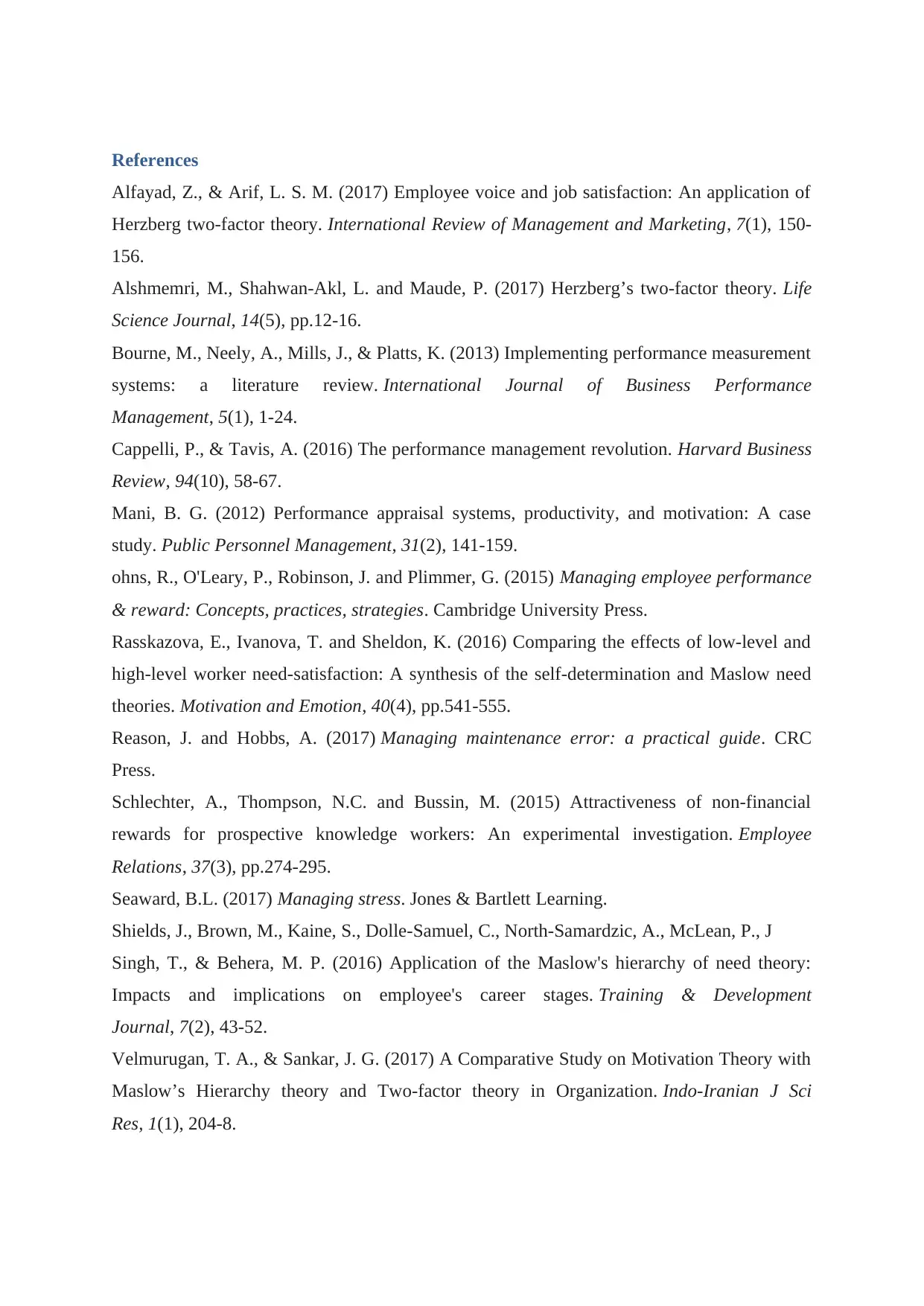
References
Alfayad, Z., & Arif, L. S. M. (2017) Employee voice and job satisfaction: An application of
Herzberg two-factor theory. International Review of Management and Marketing, 7(1), 150-
156.
Alshmemri, M., Shahwan-Akl, L. and Maude, P. (2017) Herzberg’s two-factor theory. Life
Science Journal, 14(5), pp.12-16.
Bourne, M., Neely, A., Mills, J., & Platts, K. (2013) Implementing performance measurement
systems: a literature review. International Journal of Business Performance
Management, 5(1), 1-24.
Cappelli, P., & Tavis, A. (2016) The performance management revolution. Harvard Business
Review, 94(10), 58-67.
Mani, B. G. (2012) Performance appraisal systems, productivity, and motivation: A case
study. Public Personnel Management, 31(2), 141-159.
ohns, R., O'Leary, P., Robinson, J. and Plimmer, G. (2015) Managing employee performance
& reward: Concepts, practices, strategies. Cambridge University Press.
Rasskazova, E., Ivanova, T. and Sheldon, K. (2016) Comparing the effects of low-level and
high-level worker need-satisfaction: A synthesis of the self-determination and Maslow need
theories. Motivation and Emotion, 40(4), pp.541-555.
Reason, J. and Hobbs, A. (2017) Managing maintenance error: a practical guide. CRC
Press.
Schlechter, A., Thompson, N.C. and Bussin, M. (2015) Attractiveness of non-financial
rewards for prospective knowledge workers: An experimental investigation. Employee
Relations, 37(3), pp.274-295.
Seaward, B.L. (2017) Managing stress. Jones & Bartlett Learning.
Shields, J., Brown, M., Kaine, S., Dolle-Samuel, C., North-Samardzic, A., McLean, P., J
Singh, T., & Behera, M. P. (2016) Application of the Maslow's hierarchy of need theory:
Impacts and implications on employee's career stages. Training & Development
Journal, 7(2), 43-52.
Velmurugan, T. A., & Sankar, J. G. (2017) A Comparative Study on Motivation Theory with
Maslow’s Hierarchy theory and Two-factor theory in Organization. Indo-Iranian J Sci
Res, 1(1), 204-8.
Alfayad, Z., & Arif, L. S. M. (2017) Employee voice and job satisfaction: An application of
Herzberg two-factor theory. International Review of Management and Marketing, 7(1), 150-
156.
Alshmemri, M., Shahwan-Akl, L. and Maude, P. (2017) Herzberg’s two-factor theory. Life
Science Journal, 14(5), pp.12-16.
Bourne, M., Neely, A., Mills, J., & Platts, K. (2013) Implementing performance measurement
systems: a literature review. International Journal of Business Performance
Management, 5(1), 1-24.
Cappelli, P., & Tavis, A. (2016) The performance management revolution. Harvard Business
Review, 94(10), 58-67.
Mani, B. G. (2012) Performance appraisal systems, productivity, and motivation: A case
study. Public Personnel Management, 31(2), 141-159.
ohns, R., O'Leary, P., Robinson, J. and Plimmer, G. (2015) Managing employee performance
& reward: Concepts, practices, strategies. Cambridge University Press.
Rasskazova, E., Ivanova, T. and Sheldon, K. (2016) Comparing the effects of low-level and
high-level worker need-satisfaction: A synthesis of the self-determination and Maslow need
theories. Motivation and Emotion, 40(4), pp.541-555.
Reason, J. and Hobbs, A. (2017) Managing maintenance error: a practical guide. CRC
Press.
Schlechter, A., Thompson, N.C. and Bussin, M. (2015) Attractiveness of non-financial
rewards for prospective knowledge workers: An experimental investigation. Employee
Relations, 37(3), pp.274-295.
Seaward, B.L. (2017) Managing stress. Jones & Bartlett Learning.
Shields, J., Brown, M., Kaine, S., Dolle-Samuel, C., North-Samardzic, A., McLean, P., J
Singh, T., & Behera, M. P. (2016) Application of the Maslow's hierarchy of need theory:
Impacts and implications on employee's career stages. Training & Development
Journal, 7(2), 43-52.
Velmurugan, T. A., & Sankar, J. G. (2017) A Comparative Study on Motivation Theory with
Maslow’s Hierarchy theory and Two-factor theory in Organization. Indo-Iranian J Sci
Res, 1(1), 204-8.
1 out of 7
Related Documents
Your All-in-One AI-Powered Toolkit for Academic Success.
+13062052269
info@desklib.com
Available 24*7 on WhatsApp / Email
![[object Object]](/_next/static/media/star-bottom.7253800d.svg)
Unlock your academic potential
Copyright © 2020–2025 A2Z Services. All Rights Reserved. Developed and managed by ZUCOL.




